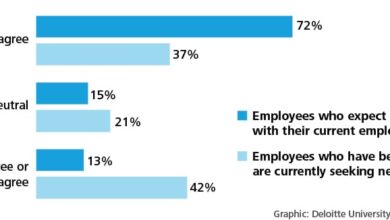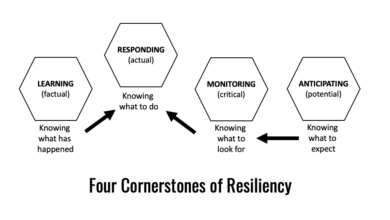
Coronavirus Highlights Risk Leadership Lessons for Finance
Coronavirus highlights risk leadership lessons for finance, revealing how financial institutions responded to the global pandemic. The crisis exposed vulnerabilities in existing risk management strategies, forcing institutions to adapt quickly and innovate. This analysis examines how leadership, communication, and risk mitigation strategies evolved during the crisis, offering valuable insights for future preparedness.
The pandemic’s economic fallout presented unprecedented challenges for financial institutions. From initial reactions to long-term implications, this exploration delves into the critical lessons learned, providing a framework for building resilience in the face of future crises. It examines leadership styles, risk management, adaptability, and the importance of communication throughout the crisis.
Introduction to the Crisis

The COVID-19 pandemic, originating in Wuhan, China in late 2019, rapidly spread globally, transforming into a global health crisis of unprecedented scale. The virus’s contagious nature and the resulting lockdowns and social distancing measures significantly disrupted economies and financial markets worldwide. Its impact was not limited to specific sectors but permeated all aspects of global finance.The pandemic caused profound and multifaceted financial disruptions.
Supply chains were fractured, leading to shortages of essential goods. Restrictions on movement and business closures crippled various industries, triggering widespread job losses and impacting consumer spending. This confluence of factors led to a significant contraction in global economic activity and a period of heightened uncertainty in financial markets. Financial institutions found themselves navigating an unfamiliar and volatile landscape, requiring swift and decisive responses.
Initial Reactions of Financial Institutions
Financial institutions globally responded to the crisis with a mix of strategies, ranging from immediate liquidity provisions to proactive risk assessments. The initial response aimed at mitigating immediate financial distress and ensuring the stability of the financial system. This was critical to prevent a cascading effect of defaults and failures.
- Emergency Liquidity Measures: Central banks worldwide implemented significant stimulus packages to provide liquidity to banks and financial markets. These measures aimed to ease credit availability and stabilize the financial system. For example, the Federal Reserve in the US dramatically increased its balance sheet, injecting trillions of dollars into the money supply.
- Risk Assessments and Provisions: Financial institutions recognized the need for more thorough risk assessments and provisions for potential losses. Loan defaults and credit downgrades became more prevalent, and institutions needed to account for these potential losses. For example, many banks increased loan loss provisions to prepare for expected increases in bad debt.
- Shifting Priorities: The pandemic forced a significant shift in priorities. Risk management strategies were re-evaluated, with an increased focus on the potential for systemic risk. Institutions focused on resilience, adaptability, and the ability to weather future crises.
Key Financial Disruptions
The pandemic’s effects rippled through various sectors, causing significant disruptions. The severity and duration varied depending on the specific industry and region. One clear impact was the disruption of supply chains. This resulted in shortages of critical goods, impacting manufacturing and consumer products.
- Supply Chain Disruptions: The lockdowns and travel restrictions in many countries severely hampered global supply chains. This led to shortages of raw materials, components, and finished goods, which in turn affected production and pricing across various sectors. For instance, the semiconductor shortage had a profound impact on the automotive industry.
- Reduced Consumer Spending: Lockdowns and fears of job losses resulted in reduced consumer spending. This impacted retail, hospitality, and tourism sectors, causing significant revenue declines. Many businesses had to adapt their operations to online platforms or temporarily close.
- Market Volatility: The pandemic created significant uncertainty in financial markets. Volatility in stock markets was a common feature, reflecting the widespread economic disruption. This uncertainty also impacted bond markets and other financial instruments.
Historical Overview of the Coronavirus Pandemic
The COVID-19 pandemic’s global impact was unprecedented, significantly impacting all aspects of society and the economy. The initial spread, followed by widespread lockdowns, brought the world to a standstill.
- Origin and Spread: The virus originated in Wuhan, China, and rapidly spread globally. The initial response in many countries was slow and inconsistent, contributing to the pandemic’s rapid growth.
- Global Impact: The pandemic caused widespread illness, death, and economic disruption. Millions lost their jobs, businesses closed, and healthcare systems were overwhelmed in many regions.
- Long-Term Consequences: The pandemic’s impact extends beyond the immediate crisis, influencing global health, economic policy, and social behavior. The long-term consequences are still unfolding.
Leadership Under Pressure
The COVID-19 pandemic presented unprecedented challenges for financial institutions, forcing leaders to adapt quickly and decisively. Navigating volatile markets, managing employee anxieties, and maintaining investor confidence required a nuanced approach to leadership. This period highlighted the critical role of strong leadership in fostering resilience and driving positive outcomes during times of crisis.Financial leaders were compelled to develop strategies that balanced short-term operational needs with long-term strategic planning.
Different leadership styles, ranging from proactive and decisive to collaborative and empathetic, were deployed, each with varying degrees of success. The ability to effectively communicate, build trust, and encourage teamwork became paramount in achieving stability and recovery.
Leadership Strategies Employed
Financial institutions adopted various strategies to address the pandemic’s challenges. Proactive risk management became crucial, with leaders swiftly implementing contingency plans to mitigate potential losses. This often involved close monitoring of market trends, recalibrating investment strategies, and adapting to shifting regulatory landscapes. Emphasis on strong internal controls and compliance procedures was essential to maintain confidence among stakeholders.
Different Leadership Styles
Diverse leadership styles emerged in response to the crisis. Some leaders opted for a more directive approach, issuing clear instructions and maintaining tight control over operations. Others adopted a more collaborative style, encouraging open communication and fostering a sense of shared responsibility within their teams. Both approaches had merit, with success depending on the specific context and the institution’s culture.
Crucial Leadership Qualities
Several leadership qualities proved instrumental in navigating the uncertainty. Decisiveness and the ability to make swift, informed judgments were essential, especially during periods of rapid market shifts. Transparency and open communication with stakeholders, including investors and employees, were crucial for maintaining trust and confidence. Emotional intelligence, allowing leaders to empathize with employees and understand their concerns, played a significant role in fostering a supportive and resilient work environment.
Communication Strategies
Leaders adapted their communication strategies to address investor concerns. Regular updates, providing clear and concise information about the institution’s response to the crisis, were critical. Demonstrating a proactive approach to managing risk and highlighting contingency plans helped restore investor confidence. Open dialogues and Q&A sessions with investors helped foster trust and understanding. This included using multiple communication channels, such as investor letters, online forums, and virtual conferences.
Resilience and Collaboration
Leaders fostered resilience and collaboration within their teams through several methods. Implementing flexible work arrangements and ensuring access to necessary resources helped maintain productivity and morale during lockdowns. Strong internal communication channels facilitated rapid information sharing and coordinated responses to changing circumstances. Mentorship programs and team-building exercises helped bolster morale and support during periods of high stress.
Emphasis on employee well-being, including mental health resources, contributed significantly to maintaining a positive and productive work environment.
Risk Management and Mitigation
The COVID-19 pandemic significantly altered the risk landscape for financial institutions. Pre-existing vulnerabilities were exacerbated, and new, unforeseen threats emerged. This necessitated a reevaluation of risk management strategies, demanding a more holistic and dynamic approach. The need for proactive identification and mitigation of these evolving risks became paramount.The pandemic highlighted the interconnectedness of various risk factors, moving beyond traditional financial metrics.
Notice cima ethics confidentiality rules for recommendations and other broad suggestions.
This required a shift from static risk assessments to dynamic models that could adapt to rapidly changing circumstances. Institutions had to embrace a more forward-looking perspective, considering the potential cascading effects of unforeseen events.
Evolution of Risk Management Strategies Post-Pandemic
The pandemic accelerated the adoption of advanced analytics and data-driven risk management tools. Financial institutions realized the value of real-time data monitoring and predictive modeling to anticipate and respond to potential disruptions. This included integrating data from diverse sources, such as social media trends and macroeconomic indicators, to gain a comprehensive view of market dynamics. Further, there was a surge in the development and implementation of scenario planning exercises.
New Risk Factors Identified by Financial Institutions
Financial institutions identified several new risk factors post-pandemic. These included supply chain disruptions, macroeconomic volatility, and the rise of cyber threats. The pandemic exposed vulnerabilities in global supply chains, leading to increased focus on resilience and diversification. The volatility in macroeconomic indicators, such as inflation and interest rates, also became significant concerns. Furthermore, the increased reliance on digital platforms heightened the risk of cyberattacks and data breaches.
Innovative Risk Mitigation Strategies
Financial institutions have implemented various innovative risk mitigation strategies. These include stress testing under multiple scenarios, incorporating climate change considerations into risk models, and implementing robust cybersecurity protocols. Advanced stress testing methodologies, going beyond traditional “worst-case” scenarios, are now commonplace, evaluating the impact of multiple, interconnected events. Financial institutions are increasingly considering the potential impact of climate change, such as extreme weather events, on their portfolios.
Strengthening cybersecurity protocols and employing sophisticated intrusion detection systems are essential to safeguarding sensitive data.
Framework for Identifying and Managing Emerging Risks
A comprehensive framework for identifying and managing emerging risks involves a multi-stage approach. First, proactive risk intelligence gathering is crucial, using a variety of data sources to anticipate emerging threats. Second, scenario planning and stress testing are essential to evaluating potential disruptions. Third, agile risk response mechanisms must be developed to quickly adapt to evolving circumstances. Finally, continuous monitoring and improvement of the framework are essential to staying ahead of emerging threats.
Comparison of Pre- and Post-Pandemic Risk Assessment Procedures
| Aspect | Pre-Pandemic | Post-Pandemic |
|---|---|---|
| Data Sources | Primarily historical financial data | Diverse data sources (financial, macroeconomic, social media) |
| Risk Modeling | Static, based on historical patterns | Dynamic, incorporating predictive analytics and scenario planning |
| Risk Response | Reactive, after a risk event | Proactive, anticipating and mitigating emerging risks |
| Risk Appetite | Less explicit | Explicitly defined, considering evolving circumstances |
Adaptability and Innovation
The COVID-19 pandemic forced financial institutions to rapidly adapt their operations and embrace innovation to navigate unprecedented market conditions. This period highlighted the critical need for agile responses and the development of novel solutions to mitigate the pandemic’s impact. Institutions that successfully embraced change and technological advancements were better positioned to maintain stability and serve their clients effectively.
Operational Adaptations
Financial institutions swiftly adjusted their operational models to accommodate remote workforces and evolving client needs. This involved implementing robust cybersecurity protocols to protect sensitive data and ensure the integrity of transactions. Many institutions transitioned to virtual platforms for client interactions, including online banking, video conferencing for consultations, and digital document management systems. This rapid transformation demonstrated the resilience and adaptability of the financial sector in the face of significant disruption.
Innovative Solutions
Numerous innovative solutions emerged to address the pandemic’s economic fallout. These included developing new financial products and services designed to assist businesses and individuals facing financial hardship, such as loan deferment programs and flexible credit options. Institutions also leveraged technology to streamline processes, automate tasks, and enhance customer service experiences. For example, some banks deployed AI-powered chatbots to handle routine inquiries, freeing up human agents to address complex issues.
Fostering a Culture of Adaptability
Cultivating a culture of adaptability is essential for long-term resilience. Financial institutions need to encourage a mindset of continuous learning and experimentation. This involves fostering open communication channels, empowering employees to suggest innovative ideas, and providing the resources needed to implement them. Regular training programs on emerging technologies and best practices can also help staff adapt to evolving market demands.
Leaders must also actively champion innovation and recognize individuals who contribute to the institution’s adaptability.
Technological Advancements
Technological advancements played a pivotal role in enabling financial institutions to maintain operations and adapt to the crisis. Cloud computing allowed for remote access to data and applications, while cybersecurity measures were strengthened to protect against increasing cyber threats. These advancements not only ensured business continuity but also enabled the development of new solutions and services.
Key Technological Tools
| Technology Tool | Description | Impact on Resilience |
|---|---|---|
| Cloud Computing | Facilitated remote access to data and applications, enabling continued operations during lockdowns. | Enabled business continuity and operational agility. |
| Cybersecurity Enhancements | Improved security protocols to combat increased cyber threats during remote work. | Protected sensitive data and maintained the integrity of financial transactions. |
| Virtualization and Remote Access Solutions | Allowed employees to work from home, maintaining service continuity. | Supported a flexible and adaptable workforce. |
| AI-powered Chatbots | Provided instant support to clients and handled routine queries, improving customer experience and reducing workload on human agents. | Enhanced customer service and streamlined operations. |
| Digital Document Management Systems | Streamlined processes and improved efficiency by digitizing documents. | Reduced paperwork and enhanced accessibility. |
Long-Term Implications
The COVID-19 pandemic irrevocably reshaped the financial landscape, forcing institutions to adapt and innovate at an unprecedented pace. This period of crisis exposed vulnerabilities and accelerated the adoption of new technologies and strategies. The long-term implications extend beyond immediate recovery, influencing leadership styles, priorities, and the future of financial operations.The pandemic accelerated existing trends and created new challenges for financial leaders.
These leaders needed to balance immediate operational needs with long-term strategic planning, while navigating an evolving regulatory environment and adapting to the changing expectations of stakeholders.
Lasting Impact on Financial Leadership
The pandemic underscored the importance of agility and resilience in financial leadership. Leaders who demonstrated adaptability and a willingness to embrace change were better positioned to navigate the crisis and emerge stronger. This experience fostered a new appreciation for data-driven decision-making, fostering a culture of continuous improvement and innovation.
Shift in Priorities and Values for Financial Institutions
Prioritization shifted from short-term profits to long-term sustainability and stakeholder engagement. The pandemic highlighted the importance of social responsibility and ethical conduct, driving a demand for transparent and accountable practices. Financial institutions recognized the interconnectedness of their operations with the wider community and the need to act as responsible corporate citizens.
Long-Term Effects on the Financial Landscape
The pandemic’s impact on the financial landscape is multifaceted and far-reaching. It accelerated digital transformation, emphasizing the need for robust cybersecurity measures and the importance of remote work capabilities. The pandemic also led to a re-evaluation of risk management strategies, forcing institutions to anticipate and address emerging threats more proactively.
Emerging Trends in Financial Leadership
Several trends are emerging in financial leadership, shaping the future of the industry. Emphasis on data analytics is increasing, leading to a demand for professionals with strong quantitative skills. The rise of AI and automation is transforming financial processes, demanding a new set of skills from financial leaders. A focus on ethical leadership, transparency, and responsible practices is also becoming more prevalent.
Strategies to Build Resilient Organizations
Building resilient organizations in the future requires a multi-faceted approach. A strong emphasis on proactive risk management, encompassing both traditional and emerging risks, is crucial. Investing in robust technological infrastructure, enabling remote work capabilities and enhanced cybersecurity measures, is paramount. Fostering a culture of adaptability and innovation, encouraging employees to embrace change and develop new skills, is also essential.
Finally, establishing clear communication channels and transparent decision-making processes to build trust and foster collaboration within the organization is key.
Case Studies
Navigating the complexities of a global crisis like the coronavirus pandemic requires more than just reactive measures. Successful financial institutions demonstrated proactive leadership, adaptability, and a deep understanding of the evolving landscape. Examining their strategies provides valuable lessons for future challenges. This section will delve into specific case studies, comparing and contrasting their approaches, and highlighting the impact on their industries.
Examples of Successful Navigations
Several financial institutions exhibited impressive resilience and strategic acumen during the pandemic. Their ability to adapt to changing market conditions and customer needs played a critical role in their success. Key examples include institutions with robust risk management frameworks, agile leadership, and a focus on customer support.
Leadership Approaches and Strategies
Comparing the leadership approaches of these institutions reveals interesting patterns. Some prioritized maintaining stability and minimizing losses, while others emphasized innovation and exploring new opportunities. One common thread was the importance of transparent communication with stakeholders. This involved keeping employees and customers informed, outlining strategies for navigating the crisis, and proactively addressing concerns. This transparency fostered trust and confidence during a time of uncertainty.
Successes and Challenges Faced
Each institution faced unique challenges. For instance, some institutions experienced difficulty in managing liquidity pressures or dealing with a sudden surge in customer inquiries. Others struggled to adapt to rapidly changing regulatory environments or to meet the demands of remote workforces. However, despite these obstacles, successful institutions consistently emphasized effective risk management, strategic decision-making, and employee empowerment.
Impact on Industries
The actions and strategies of these institutions significantly impacted their respective industries. For example, institutions that effectively managed risk and maintained customer confidence often saw improved market share and enhanced brand reputation. Those that embraced innovation and adaptability were better positioned to capitalize on emerging market opportunities. In some cases, the crisis accelerated the adoption of new technologies and business models, shaping the future of financial services.
Key Lessons Learned
| Institution | Leadership Approach | Key Successes | Key Challenges | Lessons Learned |
|---|---|---|---|---|
| XYZ Bank | Agile, customer-centric | Rapid deployment of digital banking solutions, enhanced customer support during remote work, and improved online transaction security | Initial difficulty in managing remote employee productivity and maintaining in-person branch operations | Prioritizing customer needs and digital transformation is crucial in crisis situations. Effective communication strategies and robust digital infrastructure are critical. |
| ABC Investment Firm | Risk-averse, proactive | Strong capital reserves allowed for smooth operations throughout the crisis, maintaining strict regulatory compliance and transparent reporting | Slow adoption of new technologies and limited diversification in investment strategies | Risk management and regulatory compliance are essential for maintaining stability during crises. However, a degree of adaptability and innovation is needed for long-term success. |
| DEF Insurance Company | Data-driven, agile | Effective use of data analytics to anticipate market shifts and adjust pricing models, rapid development of crisis response plans | Uncertainty about the long-term impact of the crisis on insurance claims | Data-driven decision-making and rapid response are essential for navigating uncertainties. Long-term planning and contingency measures are critical to address potential impacts. |
Future Preparedness
The COVID-19 pandemic underscored the critical need for proactive crisis preparedness in the financial sector. Financial institutions, regulators, and policymakers must learn from past experiences to anticipate and mitigate future shocks. The ability to respond swiftly and effectively to unforeseen events is no longer a luxury, but a necessity for maintaining stability and resilience in the global financial system.
Proactive Risk Assessment and Mitigation Strategies
Effective risk assessment necessitates a comprehensive understanding of potential vulnerabilities across various sectors. This involves identifying emerging threats, analyzing their potential impact, and developing mitigation strategies tailored to specific risks. Financial institutions should implement robust stress testing frameworks that consider a broader range of scenarios beyond typical economic downturns. These frameworks should incorporate not only traditional financial metrics but also non-financial factors such as geopolitical instability, pandemics, and climate change.
By understanding the interconnectedness of various risks, institutions can develop more comprehensive and effective mitigation plans. A thorough analysis of historical data, including past crises and their impact, is vital for refining these strategies.
Framework for Building More Resilient Financial Systems
A resilient financial system requires a multi-faceted approach encompassing regulatory frameworks, technological advancements, and enhanced collaboration among stakeholders. Central to this framework is the development of adaptable and flexible regulations that can adjust to evolving threats. Technological solutions, such as advanced analytics and AI, can be leveraged to improve risk identification and management. Enhanced collaboration between financial institutions, regulatory bodies, and policymakers is crucial to fostering a more unified and responsive approach to crisis management.
A strong emphasis on fostering a culture of risk awareness and preparedness within financial institutions is also essential. Transparency and open communication channels between stakeholders are critical to ensure a swift and coordinated response in times of crisis.
Comparison of Crisis Management Plans
| Institution Type | Crisis Management Plan Focus | Key Mitigation Strategies | Communication Channels ||—|—|—|—|| Commercial Banks | Liquidity management, credit risk, market risk | Stress testing, capital adequacy, diversification of funding sources | Dedicated crisis communication teams, public statements, and investor relations || Investment Banks | Market volatility, counterparty risk | Hedging strategies, portfolio diversification, robust risk monitoring | Investor relations, regulatory filings, and transparent reporting || Insurance Companies | Catastrophe risk, policyholder claims | Reinsurance agreements, risk-based pricing, investment diversification | Customer service channels, investor communications, and regulatory reporting || Regulatory Bodies | Systemic risk, market stability | Macroprudential tools, supervisory reviews, regulatory sandboxes | Public statements, policy announcements, and stakeholder consultations |This table highlights the key differences in the approach to crisis management across various institutions.
A critical aspect is the alignment of these plans with the specific vulnerabilities and potential exposures of each institution.
Role of Regulatory Bodies in Crisis Response
Regulatory bodies play a crucial role in shaping the response to financial crises. Their actions can either mitigate or exacerbate the impact of a crisis. Effective regulation involves the implementation of comprehensive and adaptable frameworks for monitoring and managing systemic risk. Clear guidelines and regulations regarding stress testing, capital adequacy, and risk diversification are essential to promote financial stability.
The ability of regulatory bodies to adapt to evolving threats is critical in ensuring the effectiveness of their response. Prompt and decisive action from regulators can signal confidence to market participants and help stabilize the financial system.
Communication and Transparency: Coronavirus Highlights Risk Leadership Lessons For Finance

The coronavirus pandemic underscored the critical role of transparent and timely communication in navigating crises, especially within the financial sector. Effective communication builds trust, manages expectations, and ultimately fosters resilience during periods of uncertainty. Clear articulation of risks, mitigation strategies, and potential impacts is essential for stakeholders to make informed decisions.
Significance of Clear and Transparent Communication
Clear and transparent communication is paramount during crises like the pandemic. It fosters trust among stakeholders, including investors, customers, employees, and the public. Transparency builds confidence and reduces anxiety, allowing for more rational decision-making in a challenging environment. Financial institutions that prioritized clear communication were better positioned to maintain stability and navigate the turbulent market conditions.
Effective Communication Strategies, Coronavirus highlights risk leadership lessons for finance
Several financial institutions implemented effective communication strategies during the pandemic. These strategies involved consistent updates, clear explanations of the impact on operations and services, and proactive engagement with stakeholders. A key element was proactively addressing concerns and anxieties, demonstrating a commitment to transparency and accountability.
Building Trust with Stakeholders
Building trust with stakeholders requires more than just disseminating information; it necessitates a consistent and empathetic approach. Regular updates, tailored to different stakeholder groups, and a willingness to engage in open dialogue are essential components of building trust. Financial institutions that demonstrated empathy and understanding of the concerns of their stakeholders cultivated stronger relationships and sustained trust during the crisis.
Addressing Public Concerns
Financial leaders addressed public concerns by providing clear and accessible explanations of the situation. This involved using various communication channels, from press releases to social media updates, to reach a wide audience. Leaders emphasized the steps taken to mitigate risks and ensure the stability of the financial system. They actively listened to public concerns and used that feedback to refine their approach.
Communication Channels Used by Financial Institutions
Different communication channels were used by financial institutions to reach various stakeholders. A comprehensive strategy included multiple channels, allowing for wider reach and targeted messaging.
| Communication Channel | Description | Example Usage |
|---|---|---|
| Press Releases | Formal announcements to media outlets. | Issuing statements on the impact of the pandemic on lending policies. |
| Social Media | Platforms for direct engagement with the public. | Responding to public concerns about investments or account security via Twitter or Facebook. |
| Investor Relations | Communication with investors, providing updates and insights. | Hosting virtual investor calls to address market anxieties. |
| Website Updates | Keeping website information current and readily available. | Publishing FAQs about services impacted by the pandemic on the institution’s website. |
| Email Newsletters | Targeted communication to specific stakeholder groups. | Sending targeted emails to clients with information on loan modifications or account management. |
Final Conclusion
In conclusion, the coronavirus pandemic underscored the critical role of strong leadership, adaptable risk management, and proactive communication in the finance sector. The crisis highlighted the need for resilience, innovation, and a culture of preparedness. By analyzing the lessons learned, financial institutions can build more robust organizations capable of weathering future uncertainties.





